We connect with Alberta-based astro and landscape photographer Chandresh “CK” Kedhambadi (@photon.chaser) to learn more about how he prepares for a glacier and ice cave exploration.
Chandresh “CK” Kedhambadi (@photon.chaser) is an astro and landscape photographer based in Alberta, Canada. CK’s work focuses on capturing the pristine beauty offered by the Canadian Rockies. He’s recently found that the glacier and ice caves of the area are some of his favorite subjects to photograph. “I utilize the Sony Alpha 7R III paired with either the Sony 24mm f/1.4 G Master or the Sony 12-24mm f/2.8 G Master for my adventures on ice,” he says. We caught up with him to learn more about documenting his experience. Keep reading as he shares more on the photography gear and safety gear he brings with him, the difference between glacier and ice caves, and why he explores them given the dangers.

Photo by Chandresh Kedhambadi. Sony Alpha 7R III. Sony 24mm f/1.4 G Master. 1/320-sec., f/11, ISO 200.
Astro and landscape photographer Chandresh “CK” Kedhambadi shares more on the photography and safety gear he uses for exploring glacier and ice caves.
A Transformed Landscape In Winter
One of the great things about living in the Canadian Rockies is the pristine beauty that winter offers for those that seek it. As winter grips the Canadian Rockies, the landscape is transformed into a magical wonderland of snow-covered mountains, frozen waterfalls, frozen lakes and one of my recent favorite subjects to photograph - glacier/ice caves. Exploring glacier/ice caves in the Canadian Rockies is a bit of a challenge, since there are very limited (if any) commercial tours unlike organized ice cave exploring compared to Iceland or Alaska. Most glacier/ice cave explorers in the Canadian Rockies are driven by the thrill and challenges of exploring and locations are tightly guarded due to the dangers associated with the glacier/ice caves and a fiduciary responsibility to preserve this fragile world.
The Dangers of Exploring Ice Caves & Risk Mitigation Strategies
As mesmerizing and beautiful the visuals of glacier/ice cave can be, it hides the dangers associated with such type of exploration. Avalanche can be a significant threat given the terrain and location, during an approach to and from a glacier/ice cave. Having an avalanche safety certification (typically AST 1) is a great way to mitigate this risk. Avalanche safety equipment (transceiver, shovel & probe) and knowledge of companion rescue is highly recommended. Having safety helmets to prevent injury from falling roof debris is best practice.

An assortment of useful safety gear for ice exploring.
Planning your trip and knowing when to go is key. The choice between summer and winter months can offer a balance of reduced risk of avalanches and hypothermia against an increased risk of cave collapse and ice integrity. Given the remote locations of these glacier/ice caves, it's highly recommended to bring along a satellite phone to communicate with search and rescue (SAR), if the need arises. Other dangers include, but not limited to river crossings, slips and falls resulting in reduced or no mobility leading to significant exposure to harsh winter conditions.
Having a concrete plan and packing safety gears (ice axe, crampons, helmets, etc.) and having the knowledge and skills to anticipate and react to the dangers are your best risk mitigation strategies.
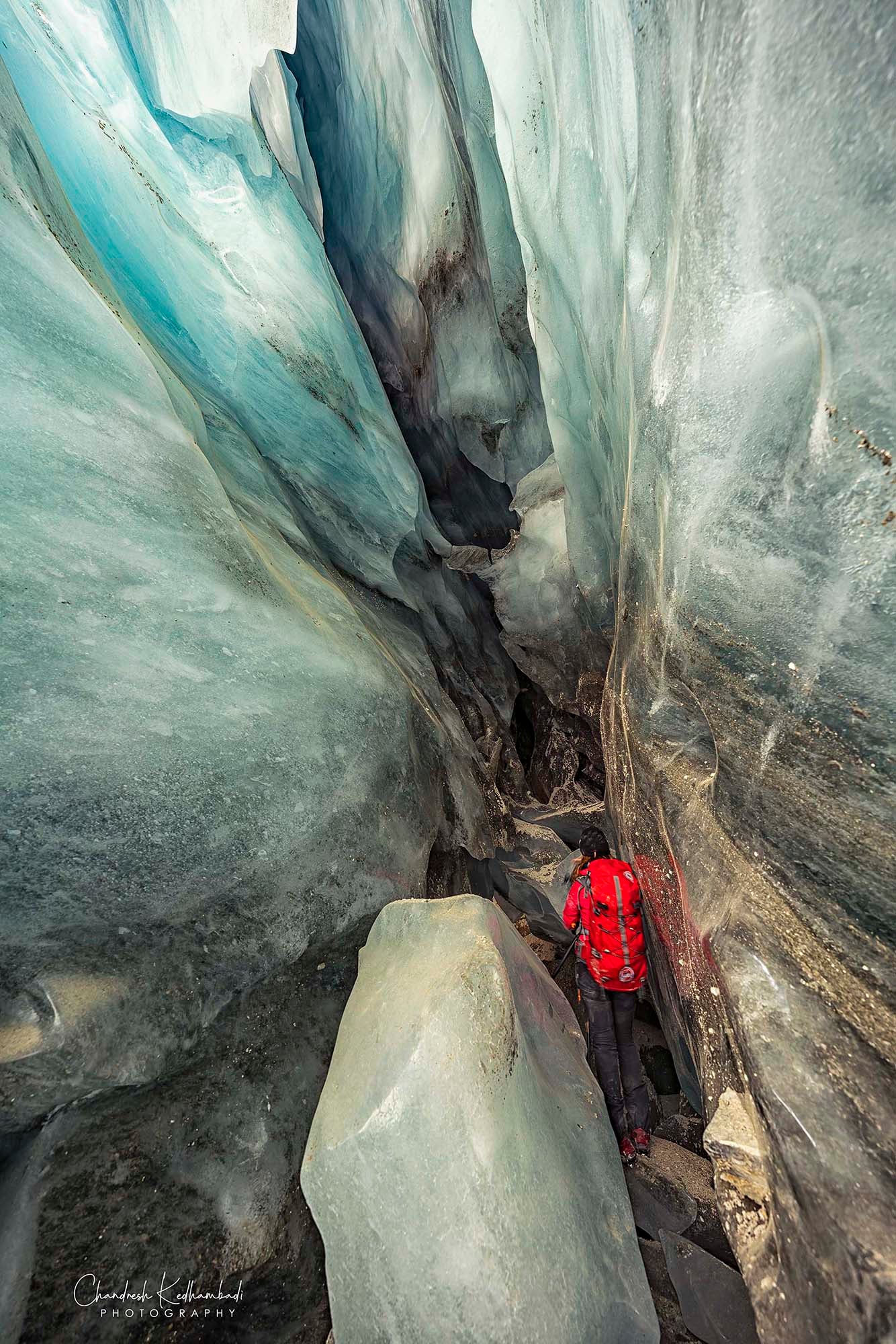
Photo by Chandresh Kedhambadi. Sony Alpha 7R III. Sony 12-24mm f/2.8 G Master. ¼-sec., f/5.6, ISO 125.
Ice Caves & Glacier Caves…What’s The Difference?
In principle, there are two types of caves with a subtle difference:
Glacier Caves: A cave that is formed completely out of ice like a glacier is commonly called a glacier cave. Glacier caves are a bit more risky (melt waters under the cave) and are constantly shifting and appear and disappear over time. They are generally characterized by its blue color (thick dense ice, sans trapped air bubbles, absorbs all visible color spectrum except blue) and are often enormous in size.
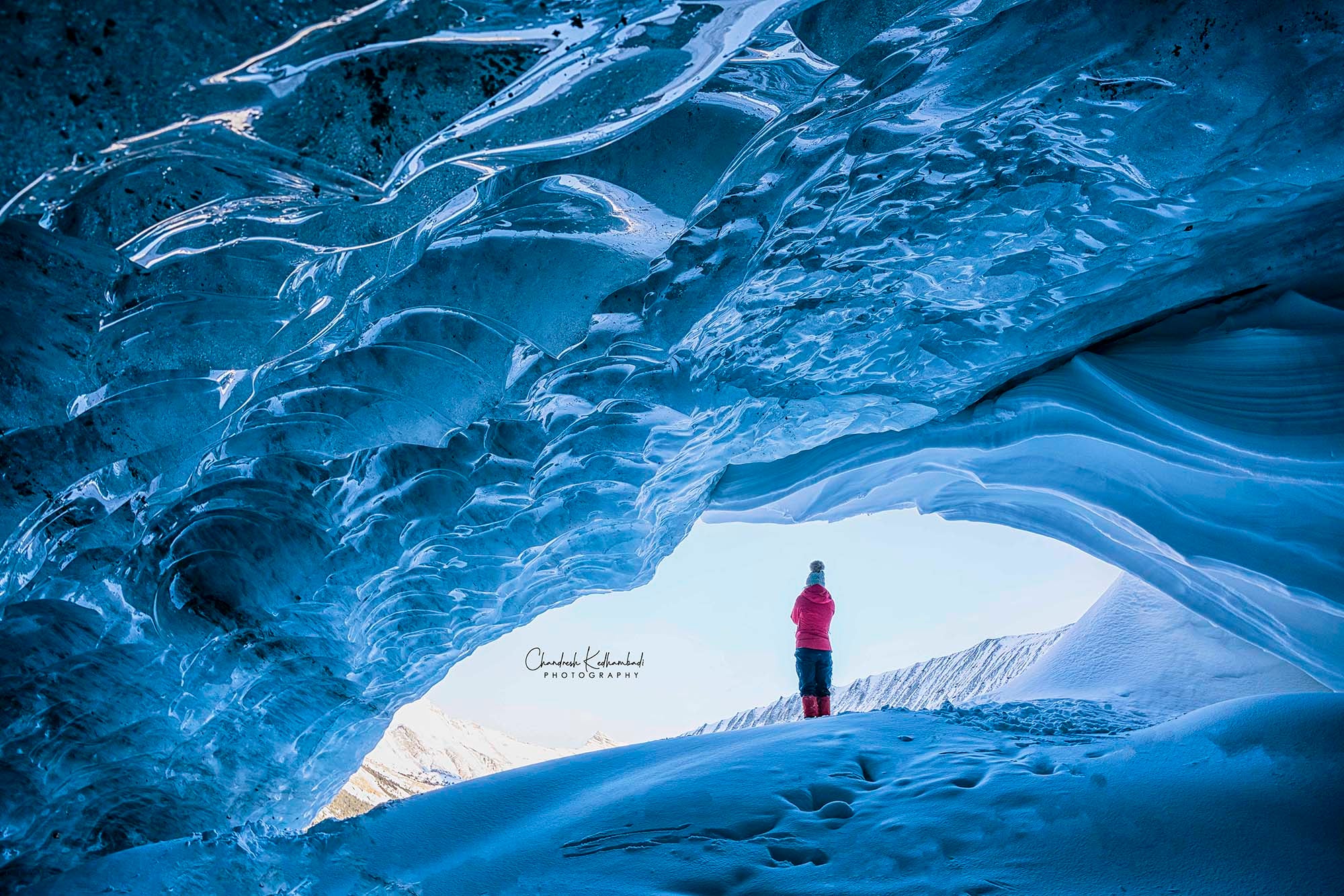
Photo by Chandresh Kedhambadi. Sony Alpha 7R III. Sony 24mm f/1.4 G Master. 1/80-sec., f/9, ISO 400.
Ice Caves: These are natural caves (rock caves) that have a portion of it with ice content, perhaps throughout the year or seasonal. Ice caves offer a mixture of colours ranging from the bluish ice to a mixture of black, red/copper colour created from the rock flour.

Photo by Chandresh Kedhambadi. Sony Alpha 7R III. Sony 12-24mm f/2.8 G Master. 1/25-sec., f/8, ISO 125.
My Photography Gear For Ice Caves
Given all the safety gear and essentials that one needs to take for an glacier/ice cave hike, it's imperative that the camera gear is limited and lightweight to save some energy during those long hikes. The Sony mirrorless camera and Sony G Master lenses offer that balance of performance and lightweight characteristics which is very desirable for such exploration.
Sony Alpha 7R III: This camera body offers uncompromising performance bundled in a compact low weight package. The resolution and the 42 Megapixels is great for large size prints and the battery performance in frigid negative 20-30 Celsius Canadian winters is ideal. For my ice cave shoots, I love the Alpha 7R III’s fast auto focus features and dynamic range. Sony Alpha 7R III offers clean noise free images for those situations where you push the ISO high to compensate for low light in certain caves. I have really come to appreciate the focus peaking and bright monitoring features on the Sony that helps easily nail my composition and focus. Considering these factors, the Sony Alpha 7R III is an ideal choice for my glacier/ice cave exploring.
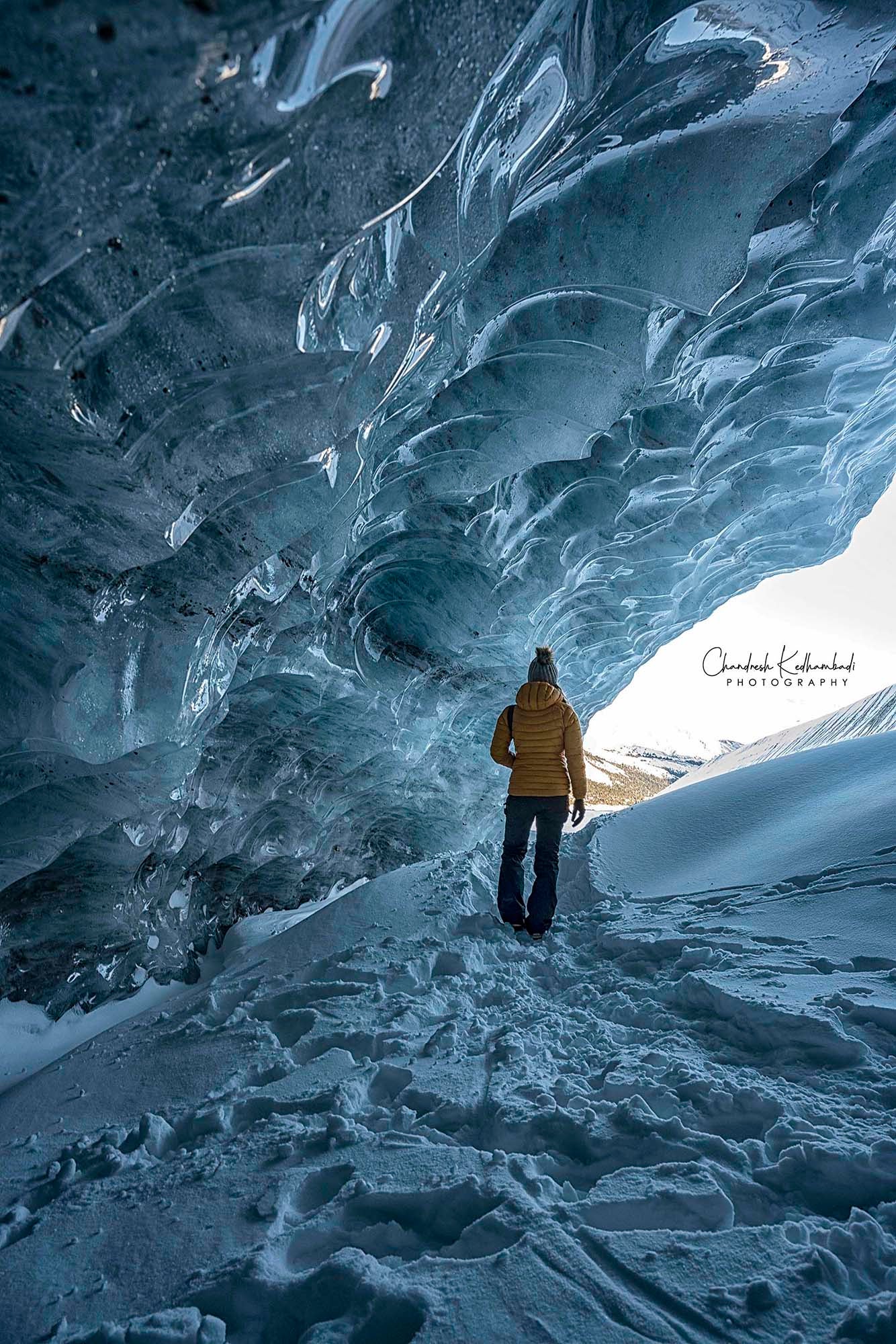
Photo by Chandresh Kedhambadi. Sony Alpha 7R III. Sony 24mm f/1.4 G Master. 1/30-sec., f/9, ISO 400.
Sony 24mm f/1.4 G Master: My main go-to option is the Sony G Master lenses. I prefer prime lenses over zoom options as the primes tend to be generally sharper and the Sony 24mm f/1.4 G Master is an ideal choice for me in terms of weight and performance. The Sony 24mm f/1.4 G Master offers best in class corner-to-corner sharpness. I love having the flexibility of a fast f/1.4 for those situations where the caves are totally dark. Also the lens has no noticeable loss of performance shooting wide open at f/1.4. I find that the 24mm is a great focal length to have, where you are able to capture the vastness of the cave and not have the details muted. The 67mm diameter filter thread is easy and flexible to account for various filters.
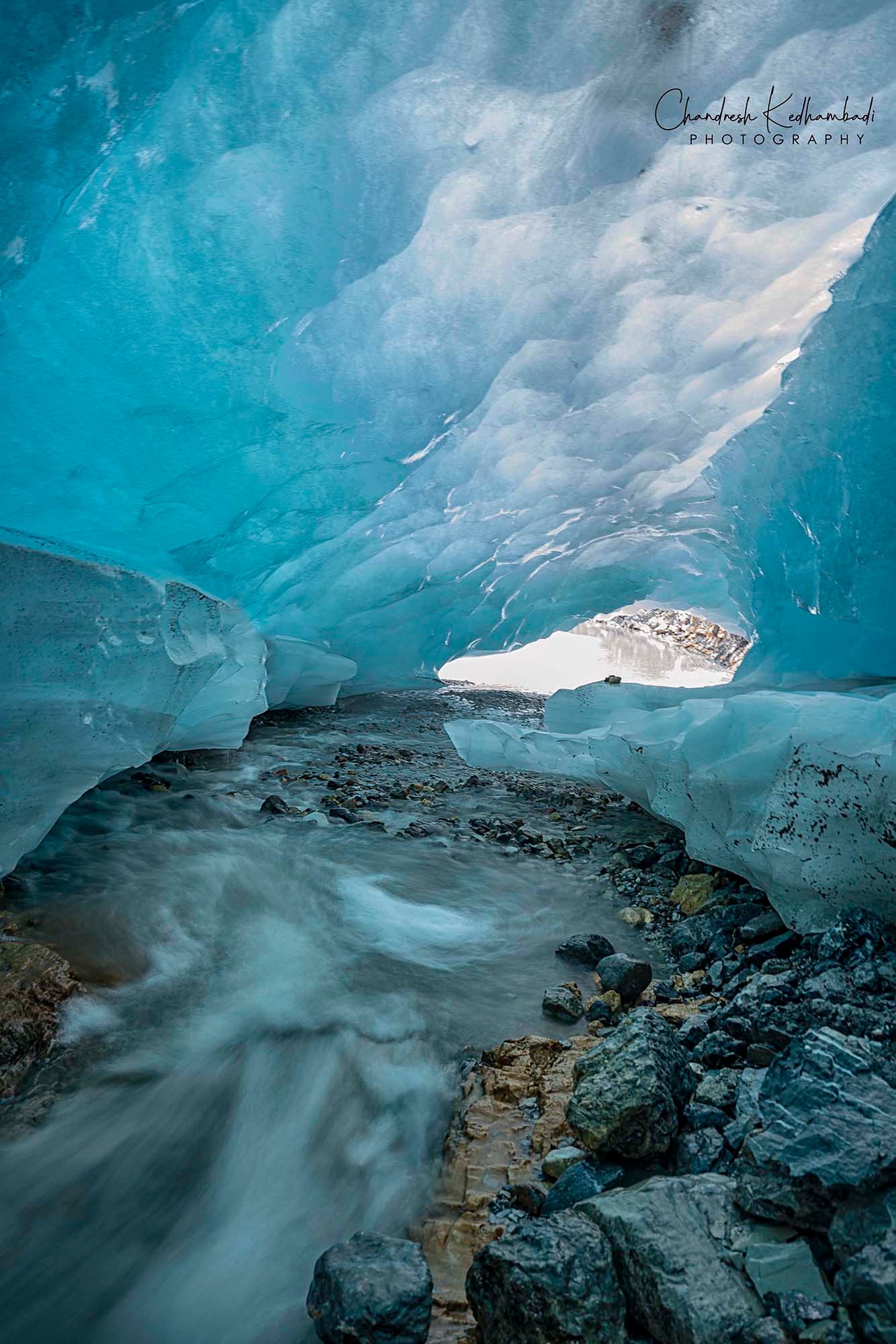
Photo by Chandresh Kedhambadi. Sony Alpha 7R III. Sony 24mm f/1.4 G Master. 1-sec., f/8, ISO 50.
Sony 12-24mm f/2.8 GM: My new addition to the Sony family, I have tried this lens for the past couple of ice cave hikes as the sole lens in my backpack. The 12 mm is wide enough to capture those massive glacier caves and 12-24 zoom gives you greater composition flexibility. The f/2.8 is ideal for low light situations. Although, heavier compared to the 24mm GM lens, the 12-24 GM lens offers the zoom flexibility without compromising on sharpness and has become my #1 choice if I am left with no option but to carry a single lens with me.
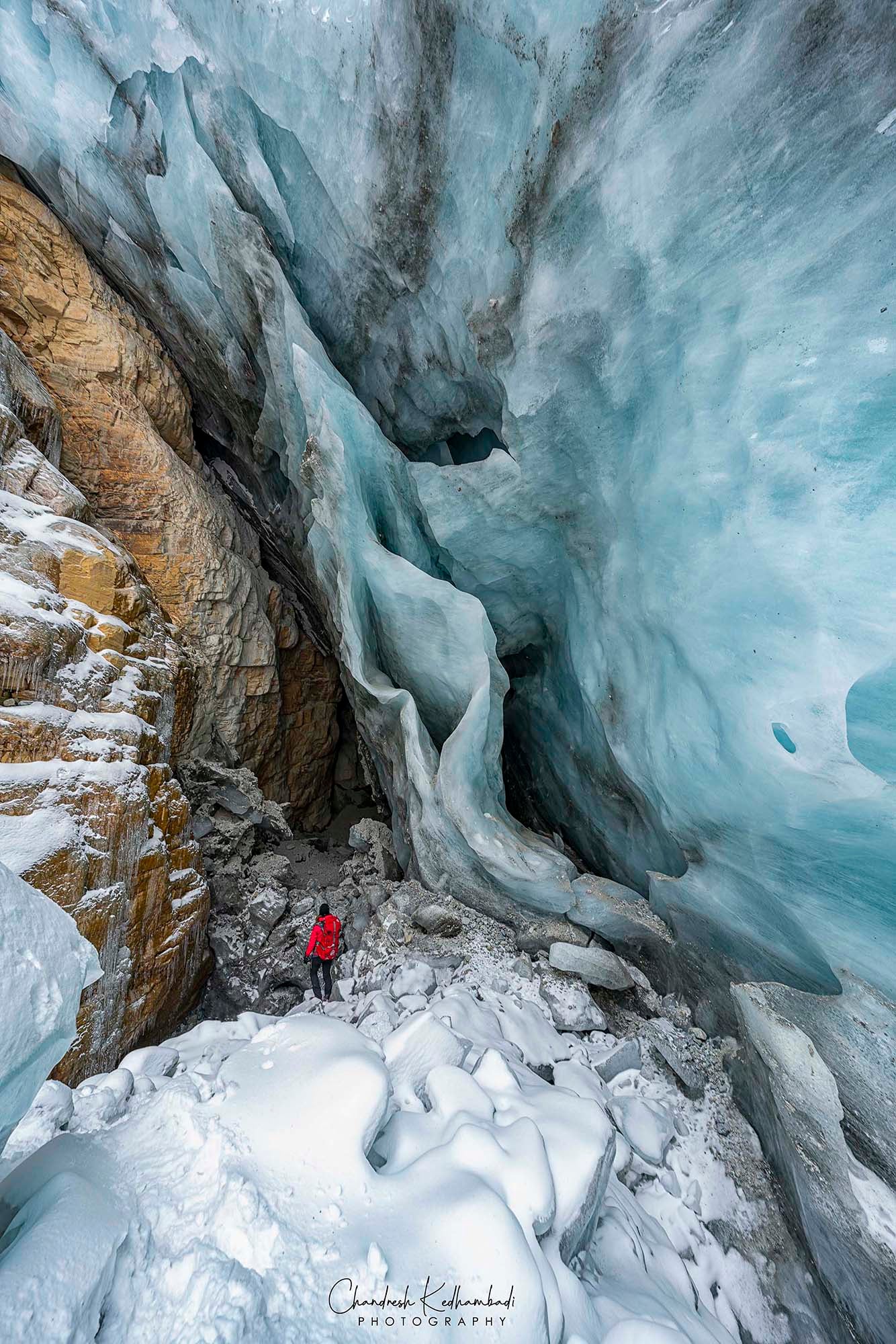
Photo by Chandresh Kedhambadi. Sony Alpha 7R III. Sony 12-24mm f/2.8 G Master. 1/13-sec., f/8, ISO 64.
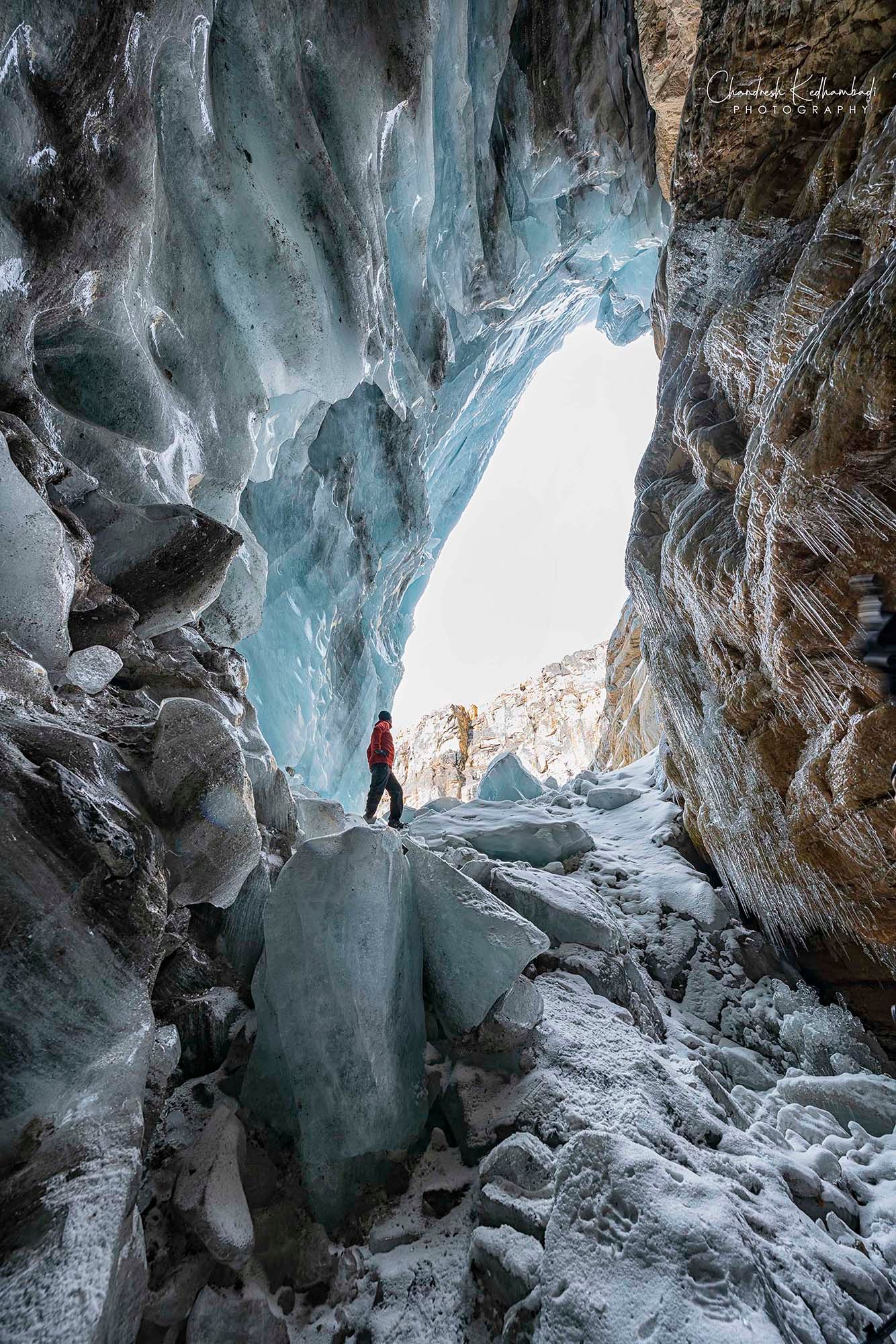
Photo by Chandresh Kedhambadi. Sony Alpha 7R III. Sony 12-24mm f/2.8 G Master. 1/25-sec., f/8, ISO 125.
The above photos, both taken with my Sony 12-24mm f/2.8 G Master at 12MM, captures the enormity of the caves. These have been by far one of the most mesmerizing entrances to an ice cave that I have come across. The human element adds to the scale and these shots epitomize the beauty and dangers of winter cave exploring.
Why Chase the Ice Caves Given the Dangers?
This is a fair question that I often get. The efforts to get to an ice cave is significant - the planning, the long arduous hike in some of the harshest weather, the risks of being buried in an avalanche, all for a few moments of bliss. It's really hard to explain those few moments of bliss in words, one has to just experience it. To me each ice cave is different and exhibits a unique character. Each cave is unique in terms of the shapes of ice, the colors and textures are stunningly beautiful to look at and yet they are so fragile and vulnerable. Each cave undergoes a significant transformation as the seasons progress, and keeps one coming back every year to see how the cave has survived its environment. The excitement of exploring builds as new caves form and the thrill of finding something big and unique is unparalleled and worth every ounce of effort in a scouting mission. To me ice caves are a perfect embodiment of nature's forces at work creating something so beautiful and mesmerizing and its permanence is not a given.
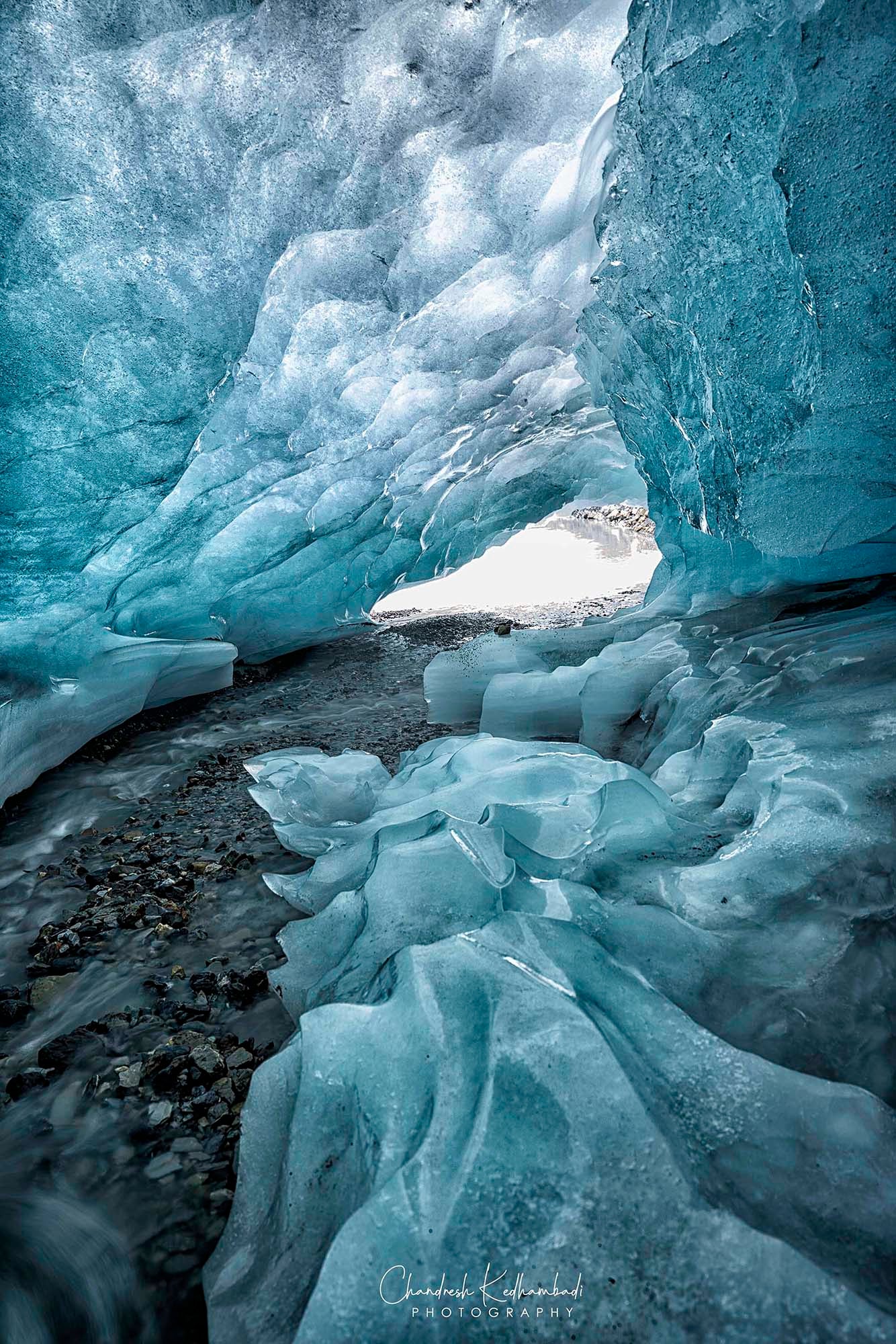
Photo by Chandresh Kedhambadi. Sony Alpha 7R III. Sony 24mm f/1.4 G Master. 1-sec., f/8, ISO 50. HDR technique reveals the trapped prehistoric air in the glacier which is useful information to scientists on the composition of early Earth’s atmosphere.
See more of C.K.'s work on Instagram @photon.chaser.



